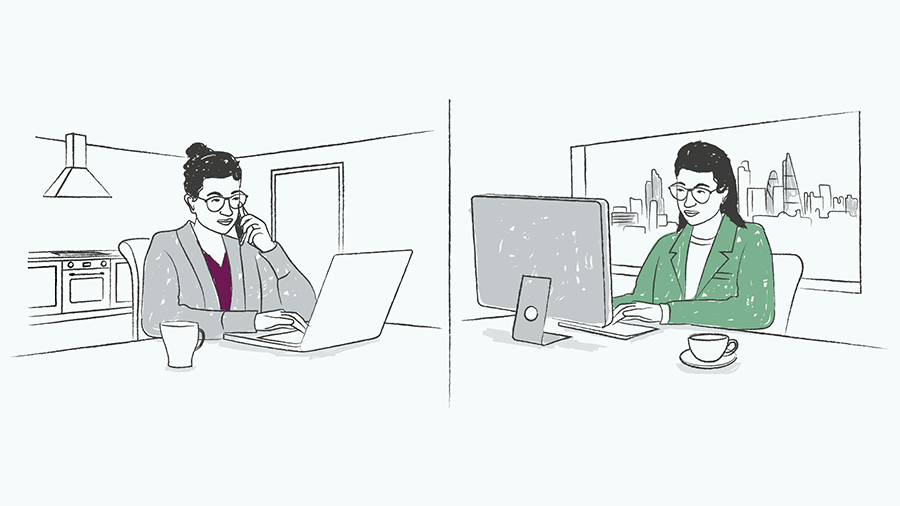
As we now know, it turned out to be premature. The alpha, delta and omicron waves ensured that the hybrid working experiment would be a long one.
Opinion is still divided over whether allowing any meaningful amount of working from home is a good idea and – even more pressingly for the leaders of businesses that depend on commuting office workers – whether hybrid working is permanent.
We have no crystal ball, sadly. The early evidence is that there has been no grand ‘back to normal’ moment, and neither does there appear to be a gradual trend towards returning.
I was speaking with the CEO of a large space retailer the other week, and they said their offices were only at 20% capacity. This CEO, like many others who have tentatively embraced hybrid working, was concerned that this is not a viable long-term solution. As they put it, “You can’t drive innovation on Teams.”
That’s received wisdom, and one of the reasons why remote-only options are quite rare: you have remote working for focused, individual tasks or for days with back-to-back one-to-one meetings, but for teamwork, creativity and innovation you want everyone together.
But is it actually true?
Fish around for evidence that remote working is bad for innovation, and you’ll find it’s inconclusive, or limited at best.
One PhD study did indicate that people felt less connected and felt they had worse shared understanding of their work – both important for collaboration – when working from home, impeding their ability to reach ‘team flow’. There have also been some surveys that suggest people believe innovation is harder remotely.
However, there is so far no sign that companies bringing their employees in five days a week are actually out-innovating those that don’t. Part of the challenge is that we haven’t had enough time to evaluate post-pandemic hybrid working approaches, which vary widely and which are still evolving.
In any case, the view that innovation is worse under hybrid conditions is largely based on personal judgements and observation.
Two specific beliefs seem to underpin this view: 1) the necessity of serendipitous ‘water-cooler’ encounters for innovation; and 2) the inadequacy of brainstorming on video calls.
Let’s look into those two beliefs a bit closer.
Water cooler moments
As Harvard Business School lecturer and collaboration expert Ethan Bernstein told the New York Times, it may sound instinctive that if you put people together it will spark a conversation, “but is that conversation likely to be helpful for innovation, creativity, [or] useful at all for what an organisation hopes people would talk about? There, there is almost no data whatsoever,” he said.
It is likely that water cooler moments are valuable for team building, and that most professionals find these happen far less in remote interactions than around actual water coolers.
However, as innovation speaker AJ Kulatunga has suggested, believing that watercooler moments create innovation gets it the wrong way around.
“Environmental collaboration only works if you’re in an organisation that has a culture that actively encourages collaboration as part of your duties. And here’s the deeper truth. If your company has such a culture, it doesn’t matter if you are face to face or not, you will find a way to collaborate and spark conversations that solve problems… the problem isn’t remote work killing innovation, it’s the way people work remotely,” Kulatunga wrote.
Brainstorming
As for the second belief, it’s a similarly back-to-front story. Yes the evidence appears to be that brainstorming, the traditional approach to in-person innovation, is worse virtually. But maybe that just means you should stop brainstorming so much.
Writing in Scientific American, behavioural scientist and author Gleb Tsipursky describes how introverts, pessimists and outsiders – who disproportionately tend to be women, juniors and people from marginalised backgrounds – can struggle with brainstorming (whether in person or virtually), reducing the number of good ideas and allowing bad ideas through.
“Numerous studies show that traditional brainstorming is substantially worse for producing innovative ideas than alternative best practices,” Tsipursky wrote. “Trying to do traditional brainstorming via videoconference is a poor substitute for the energising presence of colleagues in a conference room, thus weakening the benefits,” while also being subject to the same problems.
His proposal is to embrace asynchronous virtual collaboration, where people write ideas into a shared document, which are commented on and then discussed.
Final thoughts
There is no right answer for how much office time is optimal for innovation. If you’re Goldman Sachs and you rely on a huge number of juniors who need mentoring and camaraderie and managing, then yes, WFH is an aberration, even in small doses. If you’re a mature team in a smaller business, maybe you don’t need that much time together to spark new ideas.
What is almost certainly true is that it is easier to do things the old way because we had a century or two to figure out how to.
Our view is that hybrid working will remain a permanent fixture of our lives, if for no other reason than because we are social creatures and will ultimately choose to come in, some of the time. There is as yet no conclusive business reason that this new way of working cannot survive beyond the pandemic that ushered it in and leaders have a duty to consider what it will take to make it work.
Getting hybrid right is complex. It will require the recruitment and deployment of CEOs and directors with particularly strong leadership skills willing to inspire innovative and collaborative cultures that will thrive. So for leaders and the Chief People Officers that enable the change this will be a time to shine.
















